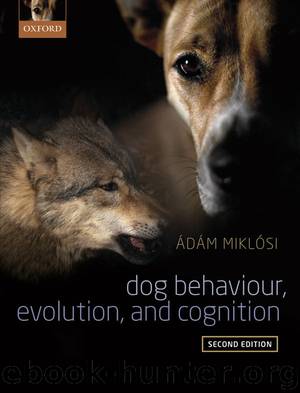Dog Behaviour, Evolution, and Cognition by Adam Miklosi

Author:Adam Miklosi [Miklosi, Adam]
Language: eng
Format: epub, mobi
Publisher: OUP Oxford
Published: 2014-12-10T23:00:00+00:00
9.2.1 Cognitive aspects of perception
In many textbooks, perceptual abilities are portrayed as part of the cognitive process (e.g. Shettleworth, 1998). Perception is an active process controlled by the central nervous system. It involves regular sampling of the environment for significant stimuli (scanning), and is affected by mental representations, which control the process of information gathering (attention and filtering), and which also guide the process of recognition. These mental representations might have a genetic component; for example, recognition of the so-called sign stimuli takes place without any prior experience; in other cases, mental representation is established as a consequence of a learning process.
From the functional point of view, the processing stimuli can be analysed in various ways. Detection means that the perceptual apparatus is able to transform the environmental stimulus into a meaningful neural signal which is capable (at least in principle) of exerting an effect on behaviour. Further neural analysis can quantify the stimulus, and finally, it could also relate the perception to other mental representations to determine its similarity (discrimination) or identity (recognition).
Although perceptual abilities can be investigated at the level of receptor cells, central neurons (e.g. single-cell recordings), or brain regions (e.g. lesions, brain waves), the focus here is on the behaviour of the whole animal (Blough and Blough, 1977). Note that under natural conditions, not all perceptions that result in neural activity are expressed in visibly active behaviour. A dog may watch events in the garden while lying motionless on the doorstep. In general, the researcher needs to put the dog in a designed experimental situation in order to investigate whether and how different stimuli are encoded by the brain, and how they control behaviour.
The choice of experimental method depends on what questions are being asked about mental functions. In the case of stimulus detection, most experiments rely on orientation behaviour. If a new stimulus (light, smell, etc.) is presented in a novel situation (in the absence of other distractions) which is within the sensory capacity of the dog, then the subject may show an orienting behaviour (e.g. turns his head in that direction). If the experimenter wants to repeat these kinds of experiments, dogs have to be trained to respond to the selected sort of stimuli. In order to detect stimulus discrimination, researchers can utilize the habituation/dishabituation method. The dog is presented with the same stimulus (or with a set of stimuli belonging to the same category) repeatedly until it loses interest (stops orienting towards it); then a new stimulus (or a stimulus belonging to a different category) is applied. If the dog is able to discriminate between the two stimuli (or two stimulus categories), then the orienting behaviour resumes. This method was used successfully for showing that dogs are able to discriminate different barking vocalizations (see section 9.4.3; Molnár et al., 2009).
Relatively new methods (at least in dog research) include expectancy-based spontaneous matching, and expectancy violation. In these paradigms, the subject is exposed to two subsequent stimuli and the reaction of the dog is expected to depend on whether it realizes the biological relationship or some contradiction between them.
Download
Dog Behaviour, Evolution, and Cognition by Adam Miklosi.mobi
This site does not store any files on its server. We only index and link to content provided by other sites. Please contact the content providers to delete copyright contents if any and email us, we'll remove relevant links or contents immediately.
Sapiens: A Brief History of Humankind by Yuval Noah Harari(14250)
Sapiens by Yuval Noah Harari(5294)
Pale Blue Dot by Carl Sagan(4912)
Homo Deus: A Brief History of Tomorrow by Yuval Noah Harari(4823)
Livewired by David Eagleman(3683)
Origin Story: A Big History of Everything by David Christian(3648)
Brief Answers to the Big Questions by Stephen Hawking(3369)
Inferior by Angela Saini(3276)
Origin Story by David Christian(3147)
Signature in the Cell: DNA and the Evidence for Intelligent Design by Stephen C. Meyer(3071)
The Gene: An Intimate History by Siddhartha Mukherjee(3047)
The Evolution of Beauty by Richard O. Prum(2938)
Aliens by Jim Al-Khalili(2787)
How The Mind Works by Steven Pinker(2729)
A Short History of Nearly Everything by Bryson Bill(2629)
Sex at Dawn: The Prehistoric Origins of Modern Sexuality by Ryan Christopher(2481)
From Bacteria to Bach and Back by Daniel C. Dennett(2444)
Endless Forms Most Beautiful by Sean B. Carroll(2431)
Who We Are and How We Got Here by David Reich(2398)
